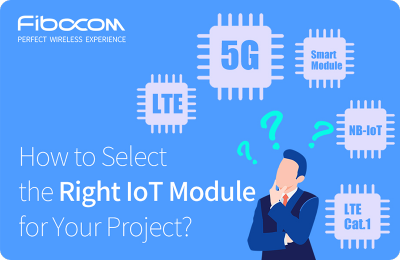A Guide to Find the Right IoT Module for Your Project

(Sponsored News) Internet of Things (IoT) bridges the gap between the physical world and the Internet world, making smarter connections possible between machines and everything. No matter for personal use or for diverse vertical industry applications, IoT addresses its significant values in greater convenience, higher efficiency, improved quality of work/production and better utilization of big data. Digital transformation has become the key to business growth, society growth and economic growth, and IoT will be at the center of digital transformation.
The emergence of more high-performance and cost-effective wireless communication technologies, as well as complicated technological specifications, give businesses more IoT opportunities and options to transform their products into future-ready devices. IoT modules, small computing components embedded in devices to enable wireless communication between the device and the network, are the most critical component in an IoT solution. But among diverse module solutions and various manufacturers available on the market, how to choose the optimal module product will be the core of a successful IoT deployment.

Different Types of Modules Available in the Market
The world of IoT is fast-evolving and technology is advancing at a flying rate around the world. Many new wireless communication solutions are becoming feasible for IoT deployment. Understanding the fundamentals of different wireless communication technology is the basis for the success of your project.
5G IoT Modules:
5G IoT technology is believed to bring revolutionary changes to the whole society. The communication technology features extremely high-speed data transmission and ultra-low latency, making it ideals for devices and scenarios which require real-time interactivity with the cloud and other smart terminals. Typical use cases of 5G communication will be often found in AI-related applications (eMBB), AR/VR devices(mMTC), industrial automation (uRLLC), high-definition live streaming/broadcasting (uRLLC) and etc. 5G IoT connections promise the best connectivity performance but are costly. Concerning 5G network construction is still in an initial stage in many countries and regions, customers must be aware of the 5G network rollout plan of local operators to select an optimal wireless communication solution.
4G LTE IoT Modules:
Before the 5G IoT technology is fully mature, 4G LTE IoT modules would still be a more prevailing choice for high broadband applications. IoT modules support LTE Cat 6 or above are considered high-speed solution. Being existing in the market for several years, 4G LTE IoT module is more developed with advanced features. Ranging from LTE Cat 4 – Cat 20, it also gives customers more options between different downlink and uplink speeds. 4G LTE IoT modules are widely used in surveillance systems, smart payment, smart home, and other high-speed scenarios.
Massive IoT Modules:
Fibocom’s massive IoT solutions are modules that features ultra-low power consumption, mainly includes LTE-Cat 1, and LPWA solutions LTE Cat-M and Narrowband IoT (NB-IoT) solutions. These series of modules have excellent cost performance and are ideal for large-scale IoT deployment that requires medium-low rate data and long battery life. NB-IoT guarantees an ultra-low power consumption and extended battery life; LTE Cat M can support voice services while maintaining low power consumption. And LTE Cat 1 is able to support voice and simple display service, and plays a greater role in mobile scenarios like smart logistics and smart law enforcement.
Smart Modules:
More interactive IoT applications will demand larger amount of data processing. Smart modules, which support certain level of computing capability, comes to play an active role in enabling multi-media playing on devices. These modules are ideal solutions especially for applications that require high-definition displays such like smart POS system, shared rider system and etc.
Automotive-Grade Modules
Automotive-grade modules are designed for C-V2X scenarios and to enable autonomous driving. They are widely used in automotive pre-factory installation and aftermarkets applications like T-Box and ADAS applications. These modules are subject to higher industry standards especially for reliability and security.
Understand Your Applications and Your Service Provider
Understand Your Project
Before you choose an IoT module product, the first and the most basic thing is to understand your product and services in order to choose a communication technology that best meets your project. Each use case has unique connectivity requirements. Choosing the IoT module with the best features, bandwidth, and price balance for each use case is a crucial step in achieving business and revenue goals. This will require customers to understand very fundamental requirements:
- The scale of deployment and the environment where your device/service will be used.
- Hardware, software, and network setup for the project.
- The data volume, accuracy and latency requirement for the project.
- The range coverage, and mobility needed for the device/service.
- Expected power consumption of the project
These requirements will decide the optimal communication technology to be used in your project. Although numerous available modules of the same communication technology are quite similar in terms of module dimensions, data rate, power consumptions, and hardware/software features, you will be able to find several models that tailor-made for your product. But to find a module that can really contribute to the revenue and the healthy growth of your business, you will need to dig deeper beyond the specifications on the datasheet.
Select an Optimal Network Service
Never forget the fact that your IoT deployment is also relying on the network service provided by operators. Understanding the connectivity requirements of your project will also help you to choose an operator, which is also vital for an IoT deployment. Although the price of modules is becoming more affordable with technological advancement, the cost of connectivity remains high since it is a long-term cost with many value-added service options. To calculate the connectivity cost, you will need to comprehend the projected numbers of connections and data volume of your project, compare the monthly or annual fee plan offered by different service providers, and research their available value-added services that will help you grow your business.
A module provided by an experienced and qualified provider like Fibocom is certified by major global operators, which will allow you to rapidly launch your product in the market with a wide variety of network service options. Unlike modules manufactured directly by cellular companies that only work with their own network and satellite system, modules offered by professional module manufacturers, by supporting worldwide operator networks, allow you to scale up your deployment for a global reach.
Choosing a Reliable Module Provider
Besides comparing the specifications provided on the module datasheet, there are also factors unobservable on the written materials that will lead to the success or failure of your projects.
Higher One-Time-Off Cost VS. Re-Occurring Problems and Risks:
As more small and new module providers emerge into the IoT market, many cheaper IoT modules are becoming available to customers with extremely attractive tag price. If we simply look at the initial deployment cost of using cheaper modules, it might look like that it saves a lot of money for the customers. But is the quality of these modules guaranteed? The process of developing a new product and making it deliverable to the market takes long and is costly. Low-quality modules always accompany a higher risk of malfunction and, to the worst extent, result in the failure of the whole project. This will not help IoT companies to generate expected project income, in reverse, it causes a greater loss in investment. From a long-term perspective, even if the product was launched to the market, the unstable performance of the module is likely to cause unwanted surprises and require frequent maintenances. This will not be simply a higher operating cost to the business, it will also harm the reputation of the brand and damage the customers’ loyalty. For the long-term growth of the business, choosing a reliable partner and quality-guaranteed module products is wise and worthy.
Future-Proof Solutions
Good module companies will not merely focus on popular products for the current market, they also look into the future trends of technology and consider technology transition of the solutions. Good providers have the ability to upgrade the software to ensure their modules can continuously support the IoT devices during the network technological transition from LTE to 5G. The module’s capability of working under different IoT network standards will also allow customers to deploy their products in different countries and regions where levels of network developments are varied. This will help customers who consider a global business expansion to reduce R&D costs and accelerate the product launch processes. Good module providers also put emphases on the security of connectivity. They work with world’s leading cybersecurity companies to deliver encrypted module solution that can effectively avoid cyber virus attacks or information leaking.
Comprehensive Support
It is important to partner with an experienced industry leader like Fibocom (we have more than 20 years of IoT module experiences) which can provide comprehensive pre-sales and post-sales services and supports. By establishing localized teams and offices, global module providers are able to react to problems and crises in a more professional and efficient manner to minimize the business loss of customers. This will also allow in-depth cooperation on the customers’ project. By doing so, module providers can help customers save time on product development by sharing expertise resources and their accumulated experiences. Indeed, the greater value lies in its capability to provide strategic values from a global perspective, giving customers insights on the local and global markets, as well as the future trend of technology.
